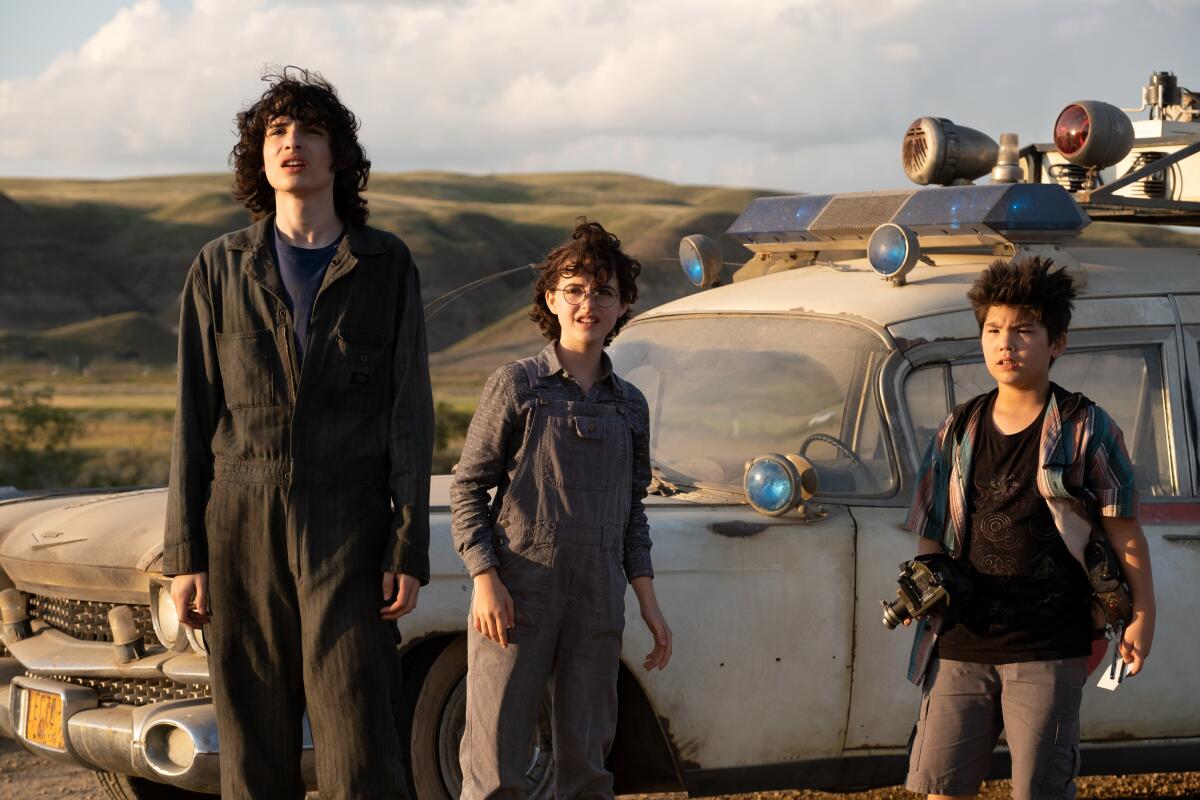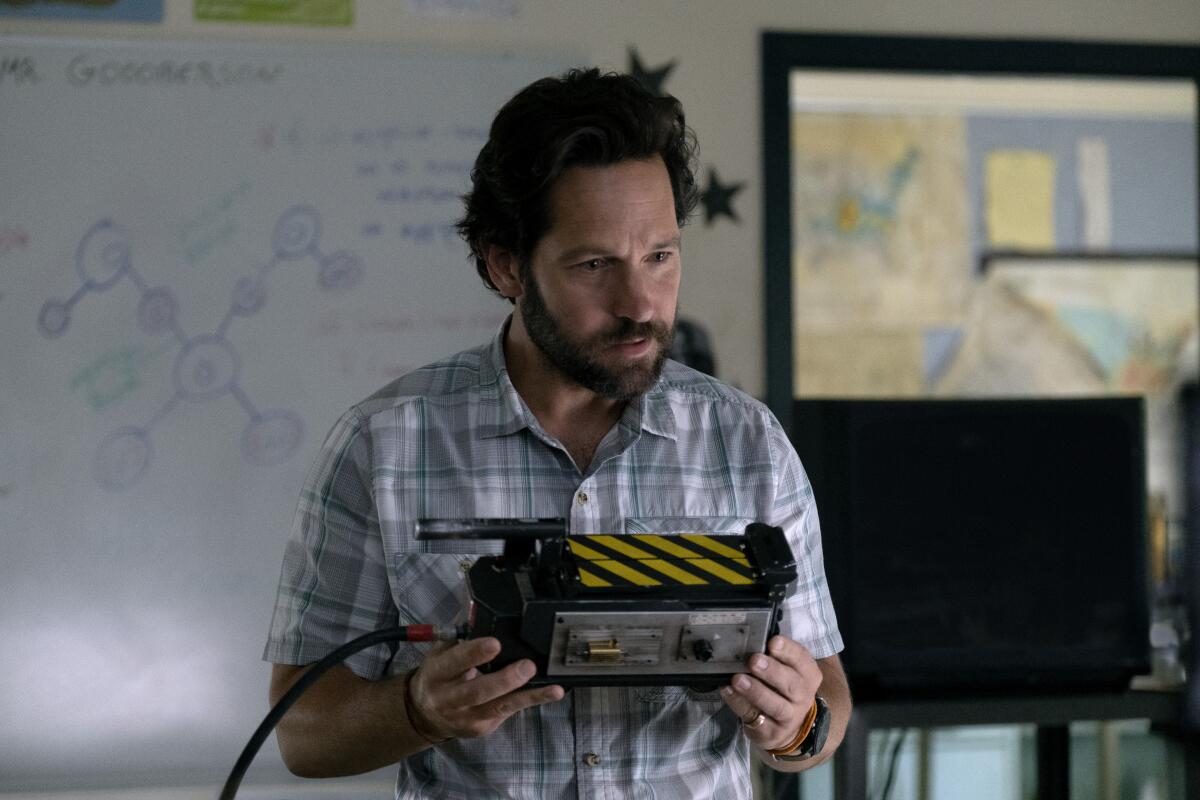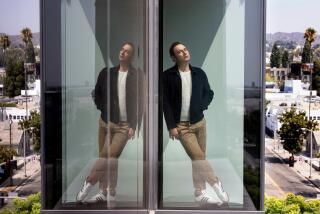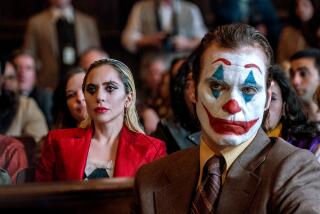Review: Listless ‘Ghostbusters: Afterlife’ fails to reanimate fun of the original

The Times is committed to reviewing theatrical film releases during the COVID-19 pandemic. Because moviegoing carries risks during this time, we remind readers to follow health and safety guidelines as outlined by the Centers for Disease Control and Prevention and local health officials.
It’s arguable whether franchise filmmaking is inherently a bad thing, but “Ghostbusters: Afterlife” certainly makes a case for those who proclaim the irredeemable soullessness of the model. Rarely has a sequel been this listless, this creatively bankrupt or this unaware of the charm and appeal of its predecessors. Rarely has a film been this craven in appeasing an imaginary audience by mimicking what came before it and refusing to challenge itself in terms of dreaming up a new world, crafting new characters or fashioning new stakes.
“Ghostbusters: Afterlife” is an ouroboros of nostalgia cannibalizing itself over and over again, an exercise in feeding contemporaneous buzzwords and concepts into a sentimental machine that chews them up and spits them out. It is not an enjoyable movie.
Arriving in theaters five years after filmmaker Paul Feig delivered a (mostly) female version of “Ghostbusters” that some (petulant) fans of this franchise decried as an abomination and helped make into a box office bomb, “Afterlife” essentially wipes clean that film’s attempt at a franchise reboot. And it also mostly ignores the events of 1989’s “Ghostbusters II,” instead focusing on 1984’s “Ghostbusters.” That approach makes some sense, given that the film’s director and producer, Ivan Reitman, is the father of Jason Reitman, who directed and co-wrote “Afterlife.”
Making this franchise a family affair isn’t the worst act of nepotism this industry has ever seen. But one of the many frustrations caused by “Afterlife” is how boxed-in this film feels, how beholden to that first “Ghostbusters” and how unwilling it is to experiment with anything new. Horror genre conventions are flirted with and abandoned; characters’ heel turns are suggested and then reversed. When it comes to deviating from an established path, “Afterlife” can’t even take the first step.
“Afterlife” is set in the present day and follows a family comprising single mother Callie (Carrie Coon), teenage son Trevor (Finn Wolfhard) and preteen daughter Phoebe (Mckenna Grace) as they move to the small, dying mining town of Summerville, Okla. Callie’s father, who abandoned the family in her youth, recently died and left her the failing farm where he spent the second half of his life. Everyone in town called the man the “Dirt Farmer,” and he was as much a mystery to them as he was to Callie.

While Callie struggles with the myriad emotions dredged up by her father’s death and unexpectedly connects with Phoebe’s summer school teacher, seismologist Gary Grooberson (Paul Rudd), Trevor and Phoebe try to fit in. Trevor crushes on fellow teen Lucky (Celeste O’Connor), while Phoebe makes her first friend in Podcast (Logan Kim); that character’s nomenclature provides a sense of this film’s sense of humor. (Nonexistent, overly reliant on simplistic wordplay, exhausting.)
For the super-smart, super-sardonic Phoebe, who has always been on the receiving end of contrasting advice from Callie and Trevor about whether she should really be herself, the dirt farm is full of mysteries. What was her grandfather working on in his secret lab? What is this backpack and wand duo that shoots energy? What was he holding in what looks like a metal trap? What are these strange etchings and mysterious rumblings found in the town’s long-unused mine?
The film fashions its action sequences around Phoebe’s discoveries, with chase scenes galore and a practically beat-for-beat re-creation of the first film’s climactic ending.
But what derails the energy of these sequences is that “Afterlife” is reliant on Phoebe and Gary, whom the film initially presents as intelligent people, making the absolute dumbest, most nonsensical decisions to move the film’s plot along. And even then, the script still links scenes together with leading dialogue like “What do you mean?” and “What is happening here?” unfurling unneeded exposition that grinds forward momentum to a stop. Why should we pay attention to “Afterlife” when the movie’s characters don’t?
Most everyone here is going very, very broad, from Wolfhard’s and Kim’s slapsticky deliveries to Grace’s persistent scowl and frown. It’s impossible to root for or sympathize with anyone, given how underwritten they are and how their only functions are to slot into preexisting character dynamics left over from previous “Ghostbusters” films. And while some might applaud “Afterlife” for making the STEM-obsessed Phoebe the film’s primary hero, it’s frustrating that the film falls into the same trap as “Star Wars: The Rise of Skywalker” with the suggestion that female characters can only wield power when they are connected to established male characters whom audiences already like.
Everything is in service of Easter eggs or recycled elements, from a return of the Stay Puft Marshmallow Man (admittedly, in the film’s funniest, most subversive scene) to the refashioning of the chunky, hungry Slimer into this film’s chunky, hungry Muncher, to — of course — someone asking, “Who you gonna call?” There is no identity to “Afterlife” past those nods backward, and no looks ahead.
Reitman’s career up until this point — in particular “Young Adult” and “Tully,” his collaborations with Diablo Cody and Charlize Theron — has been pointedly anti-nostalgic. But “Afterlife” makes one wonder what Reitman retained from those preceding projects or how much studio control was wielded to fashion this film into something they thought would sell. This isn’t homage; it’s fealty, but sapped of the zany creativity that brought this franchise to life in the first place. “Ghostbusters: Afterlife” is bleak stuff.
'Ghostbusters: Afterlife'
Rated: PG-13 for supernatural action and some suggestive references
Running time: 2 hours, 4 minutes
Playing: Starts Nov. 19 in general release
More to Read
Only good movies
Get the Indie Focus newsletter, Mark Olsen's weekly guide to the world of cinema.
You may occasionally receive promotional content from the Los Angeles Times.










